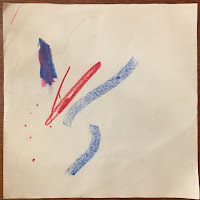These observations and stages come from my own work with children in the studio as well as from reading and observations by Ursula Kolbe, Kathleen Bailer, Howard Gardner and Rhoda Kellogg and Viktor Lowenfeld.
The images here are ones I have created to resemble children's art at each stage. Here I will focus on drawing and collage with links at the end for further reading and examples of the stages. I have settled on this version of developmental stages to share because it describes both the look of the art and the behavior of the child making the art and exploring the materials. While the stages progress they are not necessarily linear and can repeat or circle back at different times in the developmental process. An alternative title to this post could be:
Developmental Stages of Materials Exploration...
EXPLORATION
Mark making at this stage is characterized by exploration of the tools. Marks appear random and varied, often with a weak line quality. Sometimes there is evidence of the actions that make the marks such as dots that indicate tapping on the paper. Other times there are heavy marks that indicate greater pressure or explorations of using the side of a crayon.
Adults can help guide this stage by modeling and exploring alongside young children.
 In collage work, exploration is again a time of getting to know the materials. In the collage on the left, a bit of coloring in the glue allows the child to see where the glue is applied on the paper. Here the glue is applied with the brush and spread like paint. Scraps stuck down appear random and some glue is left just as marks on the paper. There is a good chance that a child may try to remove the pieces once this is dry, again testing the materials and what they will do.
In collage work, exploration is again a time of getting to know the materials. In the collage on the left, a bit of coloring in the glue allows the child to see where the glue is applied on the paper. Here the glue is applied with the brush and spread like paint. Scraps stuck down appear random and some glue is left just as marks on the paper. There is a good chance that a child may try to remove the pieces once this is dry, again testing the materials and what they will do.ENERGY
The energy stage is characterized by joy in movement and mark making. Children often have a heavy hand here, eager to cover as paper as possible with big energetic marks. There is less awareness of what the kind of marks made than just an engagement with using the material to make energetic marks. Mark making often focuses more heavily on one area of the paper or is layered. As you see on the right, children may also explore alternative ways to make marks such as the lighter lines above created by scratching back into the thickly applied oil pastel.
For collage, the energy is spent applying lots of glue and then lots of scraps. There is a randomness to the application of scraps and sometimes a pile is even dumped on top of the glue. This stage is characterized by lots of use of material and a need for support from adults to channel energy into the paper. Children will sometimes extend onto another's paper or onto the table in their enthusiasm. An adult nearby to supply new paper to receive the energy is a good way to support this stage.
SHAPE
Children transition to the shape stage when they begin to pay attention to the results of their action on the page. Movements create certain marks and children begin to see how repetitive motions make lines and circular scribbles. This is also where children begin to complete shapes, traveling the crayon around the page and returning to the starting point to create a closed shape.
This is also the stage where children may begin to name and tell stories about their images.
With collage, the shape stage is characterized by more intention in the placement of glue and pieces on the page. The collage here shows a child filling in a circle of glue in the center of the page to create a shape and then also carefully lining up scraps in a row along the bottom of the page. Shape stage continues the exploration but the energy becomes more focused and intentional.
DESIGN
The design stage is one of my favorites and points to the many ways children (and adults) use drawing and visual representation.
This stage is characterized by explorations of map making (upper left), geometric designs (lower left), intentional and ordered blocks of color arranged on the page (upper right) and radials (lower right).
Again, stories and understanding the child's intentions are important at this stage. When I first learned about this stage, it opened up for me to see children's drawing in many new and interesting ways, beyond just observational representation and to really look at ways drawing is a symbolic language.
For collage, design stage work similarly focuses on how the space is organized and sectioned on the page. Often geometric shapes divide the space and materials may be sorted into areas such as buttons in one place, felt in another and pink strips in yet another. Again, it can be interesting to hear the child's story with their creations as the designs often have much more intention and interest than may be evident from just viewing the work.
REPRESENTATION
For drawing, representation progresses from tadpole people (a version of the radial seen in the design stage) to a more schematic version of a human form. Notice how with the tadpole person, the focus is on what the child notices or deems most important. The face is huge and the legs grow from the head. Additionally, this one features fingers. Drawings of people progress to showing a torso and additional facial and clothing details. By school age most children develop a schema for how to draw a person as shown at right. With practice, drawings move from this schema toward increasing naturalistic realism.
The tree drawings below show the continued transition from the schema for natural objects, "m" birds and lollipop tree to a more naturalistic view of a tree with branches and roots and shading for the colors of the leaves.
Sometimes children will represent objects they see with collage sooner than then can draw those same objects. The ability to build with shapes in collage may help to facilitate this.
This representation with collage may also look similar to the kind of teacher-directed crafts that allow children to represent with shapes by following directions. It is important to note that while these sort of projects can model the potential for building with shapes, children need time to practice these skills on their own and come up with their own creations using open-ended materials.

This second collage shows how collage work can progress from simple flat representation to something that shows texture, layering and depth in an image. The chance to explore open-ended materials allows the creator to enter into conversation with the materials and explore and discover along the way, ultimately creating more complex images and designs.
An understanding of stages of development is an important part of facilitating process art and can help to deepen observations of children's work with materials. For examples of these stages with clay work, visit my introduction to clay powerpoint at this link.






















